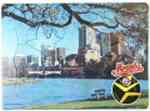Since it was established in 1955, the Moomba Festival has become an institution, unfolding in the
city’s parks, along its streets and on the waters of the Yarra River. The festival is as familiar to Melbourne as Aussie
Rules and the Melbourne Cup.
One of the biggest and longest-running festivals in Australia, Moomba has survived in spite of its
critics, and it commands a strong place in the social history of the city.
Moomba has always sought community involvement. In early festivals, post-war migrants celebrated their
cultural backgrounds through traditional costumes and performances. In the mid 60s, with a turn towards a more arts-oriented
program, Aboriginal, Jewish, Italian and Latvian arts featured prominently. Multiculturalism has been widely accepted since
the early 1990s, and cultural diversity has been well represented at Moomba ever sinceSince it was established in 1955, the
Moomba Festival has become an institution, unfolding in the city’s parks, along its streets and on the waters of the
Yarra River. The festival is as familiar to Melbourne as Aussie Rules and the Melbourne Cup.
One of the biggest and longest-running festivals in Australia, Moomba has survived in spite of its
critics, and it commands a strong place in the social history of the city.
Moomba has always sought community involvement. In early festivals, post-war migrants celebrated their
cultural backgrounds through traditional costumes and performances. In the mid 60s, with a turn towards a more arts-oriented
program, Aboriginal, Jewish, Italian and Latvian arts featured prominently. Multiculturalism has been widely accepted since
the early 1990s, and cultural diversity has been well represented at Moomba ever since
My photos were taken on Monday March 10 1958, the first Moomba Parade I went to! My vantage
point was in Swanston St, between Collins and Bourke Sts.
Lots of action on that warm and sunny day!

